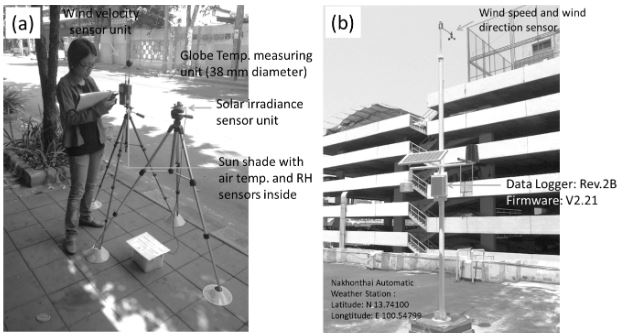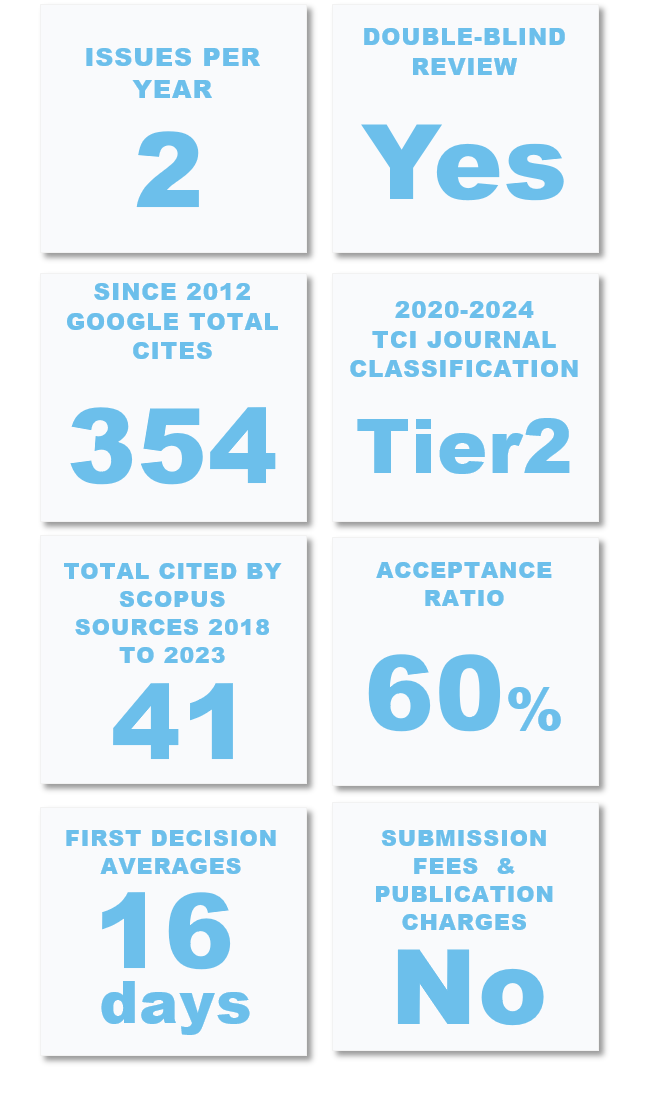Simulation of Cooling Effectiveness of Trees to Improve Outdoor Thermal Environment on Different Climate-Sensitive Urban Forms During a Summer of Bangkok
Keywords:
Green plot ratio, Thermal environment, Hot-humid tropical climate, Micro-climate modellingAbstract
This study aim to delineate an urban planning metric for greenery called the green plot ratio (GPR), is based on a common biological parameter called the leaf area density (LAD), which is defined as the portion of the single-side leaf area per unit volume of tree canopy. The study will investigate the effectiveness of GRP for urban greenery to maximize cooling benefits and potentially improve the daytime heat effect. Four climate-sensitive areas for tree planting with different Bangkok’s urban morphologies are evaluated through an urban micro-climate simulation performed by the ENVI-met model. Simulation results indicated that the cooling effect of GPRs is highly associated with urban form. Maximum air temperature reduction (a 11.2 °C reduction at the pedestrian level) is the most profound for the very high-density urban form on summer diurnal range of tropical climate, whereas the average air temperature vary linearly is reduced during the peak heat of day by 0.02°C–0.12°C by increasing GPRs. These findings will help urban planners offer better guidelines for planting and establishing urban trees to mitigate extreme heat in the hot-humid tropical environment.
Downloads
References
Aram, F., Garcia, E.H., Solgi, E., & Mansournia, S. (2019). Urban green space cooling effect in cities. Heliyon, 5, 4(April 2019), 1339.
Ballinas, M., & Barradas, V.L. (2015). The urban tree as a tool to mitigate the Urban Heat Island in Mexico city: a simple phenomenological model. Special section: the urban forest and ecosystem services. Journal of Environmental Quality. DOI:10.2134/jeq2015.01.0056.
Bruse, M., & Fleer, H. (1998). Simulating surface–plant– air interactions inside urban environments with a three dimensional numerical model. Environmental Modelling & Software, 13, Issues 3–4(October 1998), 373-384.
Choruengwiwat, J., Pongsuwan, S., Kieatkongmanee, N., Rinchumphu, D., Srivanit, M., & Yang, C.Y. (2019). The Eco-efficiency Model for Outdoor Envrionmental Design of the Mixeduse Real Estate Development in Bangkok, Thailand. Journal of Architectural/Planning Research and Studies, 16, Issue 1, 35-44.
Chow, W.T.L., & Brazel, A.J. (2012). Assessing xeriscaping as a sustainable heat island mitigation approach for a desert city. Building and Environment, 47 (January 2012),170-181.
Farhadi, H., Faizi, M., & Sanaieian, H. (2019). Mitigating the urban heat island in a residential area in Tehran: investigating the role of vegetation, materials, and orientation of buildings. Sustainable Cities and Society, 46 (April 2019), 101448
Gill, S.E., Handley, J.F., Ennos, A.R., Pauleit, S., Theuray, N., & Lindley, S.J. (2008). Characterising the urban environment of UK cities and towns: a template forlandscape planning. Landscape and Urban Planning, 87, 3 (15 September 2008), 210-222.
Lai, D., Liu, W., Gan, T., Liu, K., & Chen, Q. (2019). A review of mitigating strategies to improve the thermal environment and thermal comfort in urban outdoor spaces. Science of The Total Environment, 661, 15 (April 2019), 337-353.
Norton, B.A., Coutts, A.M., Livesley, S.J., Harris, R. J., Hunter, A. M., & Williams. N.S.G. (2015). Planning for cooler cities: a framework to prioritise green infrastructure to mitigate high temperatures in urban Landscapes. Landscape and Urban Planning, 134 (February 2015), 127-138.
Ng, E., Chen, L., Wang, Y., & Yuan, C. (2012). A study on the cooling effects of greening in a high-density city: Anexperience from Hong Kong. Building and Environment, 47 (January 2012) 256-271
Oke, T.R., (2006). Towards better scientific communication in urban climate. Theoretical and Applied Climatology, 84,179–190
Zhao, Q., Sailor, D.J., & Wentz, E.A. (2018). Impact of tree locations and arrangements on outdoor microclimates and human thermal comfort in an urban residential environment. Urban Forestry & Urban Greening, 32 (May 2018), 81–91.
Rahman, M.A., Armson, D., & Ennos, A.R. (2015). A comparison of the growth and cooling effectiveness of five commonly planted urban tree species. Urban Ecosystems, 18, 371–389.
Saaroni, H., Amorim, J.H., Hiemstra, J.A., & Pearlmutter, D. (2018). Urban Green Infrastructure as a tool for urban heat mitigation: survey of research methodologies and findings across different climatic regions. Urban Climate, 24, 94–110.
Srivanit, M., Hokao, K., & Iamtrakul, P. (2014). Classifying thermal climate zones to support urban environmental planning and management in the Bangkok Metropolitan Area. Journal of Architectural/ Planning Research and Studies, 11, (1), 73-92.
Srivanit, M., & Hokao, K. (2013). Evaluating the cooling effects of greening for improving the outdoor thermal environment at an institutional campus in the summer. Building and Environment, 66, 158-172.
Thaiutsa, B., Puangchit, L., Kjelgren, R., & Arunpraparut, W. (2008). Urban green space, street tree and heritage large tree assessment in Bangkok, Thailand. Urban Forestry & Urban Greening, 7, 219–229.
Toparlar, Y., Blocken, B., Maiheu, B., & Heijst, G. V. (2017). A review on the CFD analysis of urban microclimate. Renewable and Sustainable Energy Reviews, 80, 1613–1640.
Wong, N.H., & Yu, C. (2005). Study of green areas and urban heat island in a tropical city. Habitat International, 29, 3(September 2005), 547-558.
Yang, A.S., Juan, Y.H., Wen, C.Y., Chang, C.J. (2017). Numerical simulation of cooling effect of vegetation enhancement in a subtropical urban park. Applied Energy, 192 (15 April 2017), 178–200.
Zhao, Q., Yang, J., Wang, Z.-H., & Wentz, E. (2018). Assessing the cooling benefits of tree shade by an outdoor urban physical scale model at tempe, AZ. Urban Science, 2 (1)(January 2018), 4.
Zhou, W., Wang, J., & Cadenasso, M.L. (2017). Effects of the spatial configuration of trees on urban heat mitigation: A comparative study. Remote Sensing of Environment, 195, 15(June 2017) 1-12.
Zölch, T., Maderspacher, J., Wamsler, C., & Pauleit, S. (2016). Using green infrastructure for urban climate- proofing: an evaluation of heat mitigation measures at the micro-scale. Urban Forestry & Urban Greening, 20, 1(December 2016), 305-316

Downloads
Published
How to Cite
Issue
Section
License
Copyright (c) 2019 International Journal of Building, Urban, Interior and Landscape Technology (BUILT)

This work is licensed under a Creative Commons Attribution-NonCommercial-NoDerivatives 4.0 International License.











